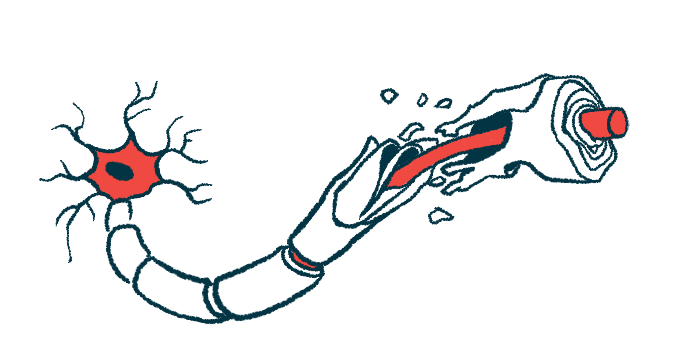Blocking SARM1 Protein Shows Promise for CMT in Type 2A Rats
SARM1 is 'executioner' of nerve fiber pathways, scientists say
Written by |

Blocking the activity of a protein known as SARM1 — called an “executioner” by scientists — may be a useful strategy in Charcot-Marie-Tooth disease (CMT), according to a new study done in a rat model of CMT type 2A (CMT2A).
According to researchers, such a strategy may prevent nerve loss in CMT and other neurodegenerative disorders.
“Our latest research suggests we … may be able to interfere with [SARM1’s] ability to drive damaging neuroinflammation,” Jeffrey Milbrandt, MD, PhD, one of the study’s senior authors and professor at Washington University School of Medicine, in Missouri, said in a press release.
“We desperately need treatments for neurodegenerative diseases,” Milbrandt said. “With the evidence of SARM1’s central role in these diseases, we’re very interested in finding ways to block this molecule — whether with small molecule inhibitors or gene therapy techniques.”
The study, “A SARM1/mitochondrial feedback loop drives neuropathogenesis in a Charcot-Marie-Tooth disease type 2A rat model,” was published in The Journal of Clinical Investigation.
Blocking SARM1 in CMT
Axons, or nerve fibers, are the long, wire-like projections that nerve cells use to connect with each other and send electrical signals. CMT2A is specifically caused by mutations in a gene called MFN2 that affects the functionality of mitochondria, the so-called powerhouses of cells.
Recent research has uncovered that the SARM1 protein is a critical mediator of a molecular pathway that leads to programmed axon destruction.
Now, a team of scientists in St. Louis conducted a series of experiments in a rat model of CMT2A to investigate this protein’s role in the disease, characterized by muscle weakness that typically begins in the legs and feet.
“SARM1 is the central executioner of the programmed axon destruction pathway, and so is a candidate to mediate axon loss in CMT2A. … If SARM1 promotes neuropathology in CMT2A, this would open new possibilities for treatment,” the researchers wrote.
After confirming that the CMT2A rat model showed abnormalities in axon development similar to what’s seen in human disease, the researchers used genetic engineering techniques to create CMT2A rats that lacked the SARM1 protein. In these rats, any reduction in axon numbers was “completely abrogated,” or nonexistent, the researchers wrote.
The CMT2A rats lacking SARM1 also showed markedly less muscle atrophy (shrinkage) and, consistently, they performed better on tests of grip strength than unaltered CMT2A rats. Knocking out SARM1 also led to marked improvements in the health of the CMT2A rats’ neuromuscular junctions, which are the connections between nerve and muscle cells.
These findings “indicate that the axon degeneration and muscle atrophy due to mitochondrial dysfunction caused by Mfn2 mutation requires SARM1 activity, demonstrating that SARM1 plays a crucial role in chronic, progressive neuropathy [nerve damage],” the researchers wrote.
In the CMT2A rats, cells showed pronounced abnormalities in mitochondria consistent with the disease model. Specifically, mitochondria counts were lower than is typical, and these cellular structures showed unusual changes in their shape or morphology. By contrast, in CMT2A rats lacking SARM1, the mitochondria “were present in normal numbers and had largely typical morphology,” the researchers reported.
“When we block SARM1, we not only protect the axons, we get much healthier mitochondria,” said Aaron DiAntonio, MD, PhD, a study co-senior author at Washington University, adding, “This was a complete surprise.”
According to the scientists, these findings indicate that SARM1 and mitochondria exhibit a feedback loop with each other in CMT2A. Poor mitochondrial health leads to activation of SARM1, which causes worse mitochondrial health, and so on, the team said.
“This discovery has important implications for the potential efficacy of SARM1 inhibition in the many neurodegenerative diseases with prominent mitochondrial dysfunction,” the researchers wrote.
“SARM1 inhibition may not only block downstream axon loss, but may also mitigate upstream mitochondrial pathology [disease] for which no current treatments exist,” they wrote.
The team noted that further work is needed to figure out the exact biochemical details of the proposed feedback loops.
In a separate study published in the same journal, a team including the same scientists report that mutations in a gene called NMNAT2, which codes for a protein that normally inhibits the axon-killing activity of SARM1, can cause a rare neurodegenerative disease in people and in mouse models. Notably, in the mouse models, the team showed that depleting immune cells called macrophages early in disease course blocked the development of nerve damage, while the same approach after symptom onset reversed nerve damage.
“We’re hopeful this work will lead to effective new therapies across a range of neurodegenerative and neuroinflammatory diseases,” Milbrandt said.



